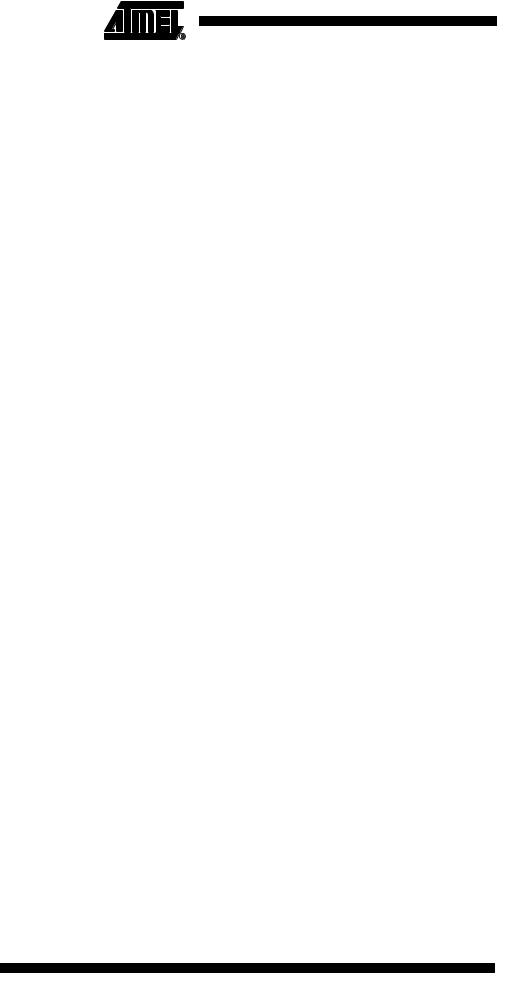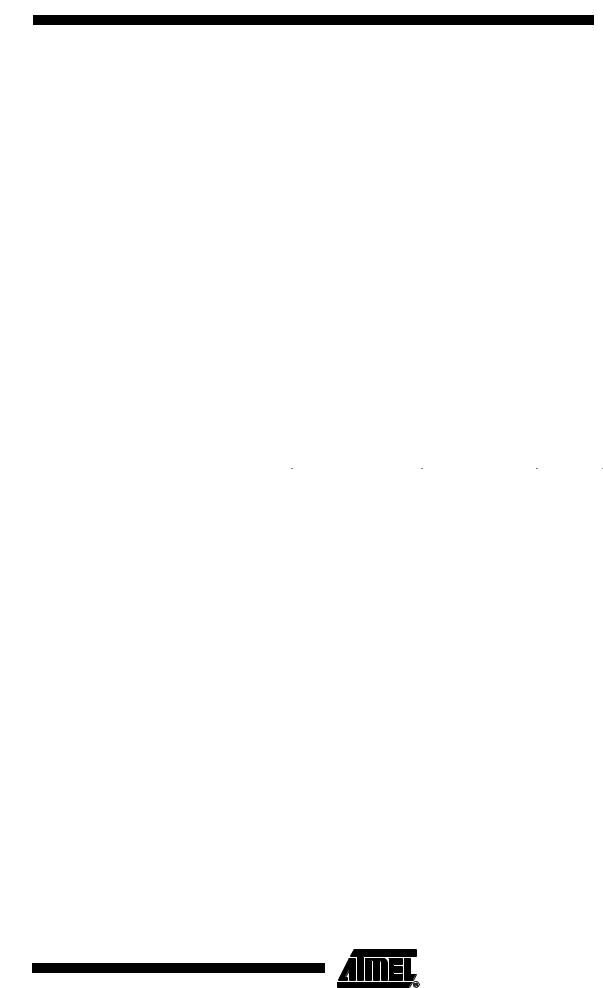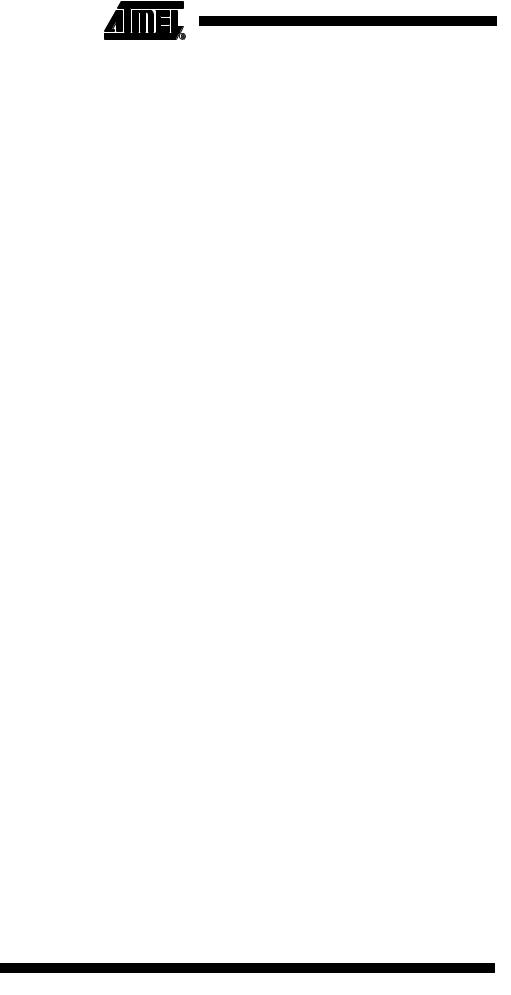
- •Features
- •Pin Configurations
- •Disclaimer
- •Overview
- •Block Diagram
- •Pin Descriptions
- •Port A (PA7..PA0)
- •Port B (PB7..PB0)
- •Port C (PC7..PC0)
- •Port D (PD7..PD0)
- •RESET
- •XTAL1
- •XTAL2
- •AVCC
- •AREF
- •AVR CPU Core
- •Introduction
- •Architectural Overview
- •Status Register
- •Stack Pointer
- •Interrupt Response Time
- •SRAM Data Memory
- •Data Memory Access Times
- •EEPROM Data Memory
- •EEPROM Read/Write Access
- •I/O Memory
- •Clock Systems and their Distribution
- •CPU Clock – clkCPU
- •I/O Clock – clkI/O
- •Flash Clock – clkFLASH
- •ADC Clock – clkADC
- •Clock Sources
- •Default Clock Source
- •Crystal Oscillator
- •External RC Oscillator
- •External Clock
- •Timer/Counter Oscillator
- •Idle Mode
- •Power-down Mode
- •Power-save Mode
- •Standby Mode
- •Extended Standby Mode
- •Analog to Digital Converter
- •Analog Comparator
- •Brown-out Detector
- •Internal Voltage Reference
- •Watchdog Timer
- •Port Pins
- •Resetting the AVR
- •Reset Sources
- •Power-on Reset
- •External Reset
- •Brown-out Detection
- •Watchdog Reset
- •Watchdog Timer
- •Interrupts
- •I/O Ports
- •Introduction
- •Configuring the Pin
- •Reading the Pin Value
- •Unconnected pins
- •Alternate Port Functions
- •Alternate Functions of Port A
- •Alternate Functions of Port B
- •Alternate Functions of Port C
- •Alternate Functions of Port D
- •Port A Data Register – PORTA
- •Port B Data Register – PORTB
- •Port C Data Register – PORTC
- •Port D Data Register – PORTD
- •External Interrupts
- •8-bit Timer/Counter0 with PWM
- •Overview
- •Registers
- •Definitions
- •Counter Unit
- •Output Compare Unit
- •Force Output Compare
- •Modes of Operation
- •Normal Mode
- •Fast PWM Mode
- •Phase Correct PWM Mode
- •Internal Clock Source
- •Prescaler Reset
- •External Clock Source
- •16-bit Timer/Counter1
- •Overview
- •Registers
- •Definitions
- •Compatibility
- •Counter Unit
- •Input Capture Unit
- •Input Capture Trigger Source
- •Noise Canceler
- •Using the Input Capture Unit
- •Output Compare Units
- •Force Output Compare
- •Modes of Operation
- •Normal Mode
- •Fast PWM Mode
- •Phase Correct PWM Mode
- •8-bit Timer/Counter2 with PWM and Asynchronous Operation
- •Overview
- •Registers
- •Definitions
- •Counter Unit
- •Output Compare Unit
- •Force Output Compare
- •Modes of Operation
- •Normal Mode
- •Fast PWM Mode
- •Phase Correct PWM Mode
- •Timer/Counter Prescaler
- •SS Pin Functionality
- •Slave Mode
- •Master Mode
- •SPI Control Register – SPCR
- •SPI Status Register – SPSR
- •SPI Data Register – SPDR
- •Data Modes
- •USART
- •Overview
- •AVR USART vs. AVR UART – Compatibility
- •Clock Generation
- •External Clock
- •Synchronous Clock Operation
- •Frame Formats
- •Parity Bit Calculation
- •USART Initialization
- •Parity Generator
- •Disabling the Transmitter
- •Receiver Error Flags
- •Parity Checker
- •Disabling the Receiver
- •Flushing the Receive Buffer
- •Asynchronous Data Recovery
- •Using MPCM
- •Write Access
- •Read Access
- •Two-wire Serial Interface
- •Features
- •TWI Terminology
- •Electrical Interconnection
- •Transferring Bits
- •START and STOP Conditions
- •Address Packet Format
- •Data Packet Format
- •Overview of the TWI Module
- •SCL and SDA Pins
- •Bit Rate Generator Unit
- •Bus Interface Unit
- •Address Match Unit
- •Control Unit
- •TWI Register Description
- •TWI Bit Rate Register – TWBR
- •TWI Control Register – TWCR
- •TWI Status Register – TWSR
- •TWI Data Register – TWDR
- •Using the TWI
- •Transmission Modes
- •Master Transmitter Mode
- •Master Receiver Mode
- •Slave Receiver Mode
- •Slave Transmitter Mode
- •Miscellaneous States
- •Analog Comparator
- •Analog Comparator Multiplexed Input
- •Features
- •Operation
- •Starting a Conversion
- •Differential Gain Channels
- •Changing Channel or Reference Selection
- •ADC Input Channels
- •ADC Voltage Reference
- •ADC Noise Canceler
- •Analog Input Circuitry
- •ADC Accuracy Definitions
- •ADC Conversion Result
- •ADLAR = 0
- •ADLAR = 1
- •Features
- •Overview
- •Test Access Port – TAP
- •TAP Controller
- •PRIVATE0; $8
- •PRIVATE1; $9
- •PRIVATE2; $A
- •PRIVATE3; $B
- •Bibliography
- •Features
- •System Overview
- •Data Registers
- •Bypass Register
- •Device Identification Register
- •Reset Register
- •Boundary-scan Chain
- •EXTEST; $0
- •IDCODE; $1
- •SAMPLE_PRELOAD; $2
- •AVR_RESET; $C
- •BYPASS; $F
- •Scanning the Digital Port Pins
- •Scanning the RESET Pin
- •Scanning the Clock Pins
- •Scanning the ADC
- •Features
- •Application Section
- •BLS – Boot Loader Section
- •Read-While-Write and no Read-While-Write Flash Sections
- •Boot Loader Lock Bits
- •Performing a Page Write
- •Using the SPM Interrupt
- •Setting the Boot Loader Lock Bits by SPM
- •Reading the Fuse and Lock Bits from Software
- •Preventing Flash Corruption
- •Fuse Bits
- •Latching of Fuses
- •Signature Bytes
- •Calibration Byte
- •Signal Names
- •Parallel Programming
- •Enter Programming Mode
- •Chip Erase
- •Programming the Flash
- •Programming the EEPROM
- •Reading the Flash
- •Reading the EEPROM
- •Programming the Lock Bits
- •Reading the Signature Bytes
- •Reading the Calibration Byte
- •SPI Serial Downloading
- •Data Polling Flash
- •Data Polling EEPROM
- •AVR_RESET ($C)
- •PROG_ENABLE ($4)
- •PROG_COMMANDS ($5)
- •PROG_PAGELOAD ($6)
- •PROG_PAGEREAD ($7)
- •Data Registers
- •Reset Register
- •Programming Enable Register
- •Virtual Flash Page Read Register
- •Programming Algorithm
- •Entering Programming Mode
- •Leaving Programming Mode
- •Performing Chip Erase
- •Programming the Flash
- •Reading the Flash
- •Programming the EEPROM
- •Reading the EEPROM
- •Programming the Fuses
- •Programming the Lock Bits
- •Reading the Signature Bytes
- •Reading the Calibration Byte
- •Electrical Characteristics
- •Absolute Maximum Ratings*
- •DC Characteristics
- •External Clock Drive Waveforms
- •External Clock Drive
- •Two-wire Serial Interface Characteristics
- •ADC Characteristics
- •Register Summary
- •Instruction Set Summary
- •Ordering Information
- •Packaging Information
- •Errata
- •ATmega32 Rev. A
- •Datasheet Change Log for ATmega32
- •Changes from Rev. 2503E-09/03 to Rev. 2503F-12/03
- •Changes from Rev. 2503D-02/03 to Rev. 2503E-09/03
- •Changes from Rev. 2503C-10/02 to Rev. 2503D-02/03
- •Changes from Rev. 2503B-10/02 to Rev. 2503C-10/02
- •Changes from Rev. 2503A-03/02 to Rev. 2503B-10/02
- •Table of Contents

Alternate Functions of Port C The Port C pins with alternate functions are shown in Table 28. If the JTAG interface is enabled, the pull-up resistors on pins PC5(TDI), PC3(TMS) and PC2(TCK) will be activated even if a reset occurs.
Table 28. Port C Pins Alternate Functions
Port Pin |
Alternate Function |
|
|
PC7 |
TOSC2 (Timer Oscillator Pin 2) |
|
|
PC6 |
TOSC1 (Timer Oscillator Pin 1) |
|
|
PC5 |
TDI (JTAG Test Data In) |
|
|
PC4 |
TDO (JTAG Test Data Out) |
|
|
PC3 |
TMS (JTAG Test Mode Select) |
|
|
PC2 |
TCK (JTAG Test Clock) |
|
|
PC1 |
SDA (Two-wire Serial Bus Data Input/Output Line) |
|
|
PC0 |
SCL (Two-wire Serial Bus Clock Line) |
|
|
The alternate pin configuration is as follows:
• TOSC2 – Port C, Bit 7
TOSC2, Timer Oscillator pin 2: When the AS2 bit in ASSR is set (one) to enable asynchronous clocking of Timer/Counter2, pin PC7 is disconnected from the port, and becomes the inverting output of the Oscillator amplifier. In this mode, a Crystal Oscillator is connected to this pin, and the pin can not be used as an I/O pin.
• TOSC1 – Port C, Bit 6
TOSC1, Timer Oscillator pin 1: When the AS2 bit in ASSR is set (one) to enable asynchronous clocking of Timer/Counter2, pin PC6 is disconnected from the port, and becomes the input of the inverting Oscillator amplifier. In this mode, a Crystal Oscillator is connected to this pin, and the pin can not be used as an I/O pin.
• TDI – Port C, Bit 5
TDI, JTAG Test Data In: Serial input data to be shifted in to the Instruction Register or Data Register (scan chains). When the JTAG interface is enabled, this pin can not be used as an I/O pin.
• TDO – Port C, Bit 4
TDO, JTAG Test Data Out: Serial output data from Instruction Register or Data Register. When the JTAG interface is enabled, this pin can not be used as an I/O pin.
The TD0 pin is tri-stated unless TAP states that shifts out data are entered.
• TMS – Port C, Bit 3
TMS, JTAG Test Mode Select: This pin is used for navigating through the TAP-controller state machine. When the JTAG interface is enabled, this pin can not be used as an I/O pin.
58 ATmega32(L)
2503F–AVR–12/03

ATmega32(L)
• TCK – Port C, Bit 2
TCK, JTAG Test Clock: JTAG operation is synchronous to TCK. When the JTAG interface is enabled, this pin can not be used as an I/O pin.
• SDA – Port C, Bit 1
SDA, Two-wire Serial Interface Data: When the TWEN bit in TWCR is set (one) to enable the Two-wire Serial Interface, pin PC1 is disconnected from the port and becomes the Serial Data I/O pin for the Two-wire Serial Interface. In this mode, there is a spike filter on the pin to suppress spikes shorter than 50 ns on the input signal, and the pin is driven by an open drain driver with slew-rate limitation. When this pin is used by the Two-wire Serial Interface, the pull-up can still be controlled by the PORTC1 bit.
• SCL – Port C, Bit 0
SCL, Two-wire Serial Interface Clock: When the TWEN bit in TWCR is set (one) to enable the Two-wire Serial Interface, pin PC0 is disconnected from the port and becomes the Serial Clock I/O pin for the Two-wire Serial Interface. In this mode, there is a spike filter on the pin to suppress spikes shorter than 50 ns on the input signal, and the pin is driven by an open drain driver with slew-rate limitation. When this pin is used by the Two-wire Serial Interface, the pull-up can still be controlled by the PORTC0 bit.
Table 29 and Table 30 relate the alternate functions of Port C to the overriding signals shown in Figure 26 on page 52.
Table 29. Overriding Signals for Alternate Functions in PC7..PC4
Signal |
|
|
|
|
Name |
PC7/TOSC2 |
PC6/TOSC1 |
PC5/TDI |
PC4/TDO |
|
|
|
|
|
PUOE |
AS2 |
AS2 |
JTAGEN |
JTAGEN |
|
|
|
|
|
PUOV |
0 |
0 |
1 |
0 |
|
|
|
|
|
DDOE |
AS2 |
AS2 |
JTAGEN |
JTAGEN |
|
|
|
|
|
DDOV |
0 |
0 |
0 |
SHIFT_IR + SHIFT_DR |
|
|
|
|
|
PVOE |
0 |
0 |
0 |
JTAGEN |
|
|
|
|
|
PVOV |
0 |
0 |
0 |
TDO |
|
|
|
|
|
DIEOE |
AS2 |
AS2 |
JTAGEN |
JTAGEN |
|
|
|
|
|
DIEOV |
0 |
0 |
0 |
0 |
|
|
|
|
|
DI |
– |
– |
– |
– |
|
|
|
|
|
AIO |
T/C2 OSC OUTPUT |
T/C2 OSC INPUT |
TDI |
– |
|
|
|
|
|
59
2503F–AVR–12/03

Table 30. Overriding Signals for Alternate Functions in PC3..PC0(1)
Signal |
|
|
|
|
|
|
|
|
|
Name |
|
PC3/TMS |
PC2/TCK |
PC1/SDA |
PC0/SCL |
||||
|
|
|
|
|
|
||||
PUOE |
|
JTAGEN |
JTAGEN |
TWEN |
TWEN |
||||
|
|
|
|
|
|
|
|
|
|
PUOV |
|
1 |
1 |
PORTC1 • |
|
|
PORTC0 • |
|
|
PUD |
PUD |
||||||||
|
|
|
|
|
|
||||
DDOE |
|
JTAGEN |
JTAGEN |
TWEN |
TWEN |
||||
|
|
|
|
|
|
||||
DDOV |
|
0 |
0 |
SDA_OUT |
SCL_OUT |
||||
|
|
|
|
|
|
||||
PVOE |
|
0 |
0 |
TWEN |
TWEN |
||||
|
|
|
|
|
|
|
|
|
|
PVOV |
|
0 |
0 |
0 |
|
|
0 |
|
|
|
|
|
|
|
|
|
|
|
|
DIEOE |
|
JTAGEN |
JTAGEN |
0 |
|
|
0 |
|
|
|
|
|
|
|
|
|
|
|
|
DIEOV |
|
0 |
0 |
0 |
|
|
0 |
|
|
|
|
|
|
|
|
||||
DI |
|
– |
– |
– |
– |
||||
|
|
|
|
|
|
||||
AIO |
|
TMS |
TCK |
SDA INPUT |
SCL INPUT |
||||
|
|
|
|
|
|
||||
Note: 1. |
When enabled, the Two-wire Serial Interface enables slew-rate controls on the output |
||||||||
|
pins PC0 and PC1. This is not shown in the figure. In addition, spike filters are con- |
||||||||
|
nected between the AIO outputs shown in the port figure and the digital logic of the |
||||||||
|
TWI module. |
|
|
|
|
|
|
|
|
Alternate Functions of Port D The Port D pins with alternate functions are shown in Table 31.
Table 31. Port D Pins Alternate Functions
Port Pin |
Alternate Function |
|
|
PD7 |
OC2 (Timer/Counter2 Output Compare Match Output) |
|
|
PD6 |
ICP (Timer/Counter1 Input Capture Pin) |
|
|
PD5 |
OC1A (Timer/Counter1 Output Compare A Match Output) |
|
|
PD4 |
OC1B (Timer/Counter1 Output Compare B Match Output) |
|
|
PD3 |
INT1 (External Interrupt 1 Input) |
|
|
PD2 |
INT0 (External Interrupt 0 Input) |
|
|
PD1 |
TXD (USART Output Pin) |
|
|
PD0 |
RXD (USART Input Pin) |
|
|
The alternate pin configuration is as follows:
• OC2 – Port D, Bit 7
OC2, Timer/Counter2 Output Compare Match output: The PD7 pin can serve as an external output for the Timer/Counter2 Output Compare. The pin has to be configured as an output (DDD7 set (one)) to serve this function. The OC2 pin is also the output pin for the PWM mode timer function.
• ICP – Port D, Bit 6
ICP – Input Capture Pin: The PD6 pin can act as an Input Capture pin for
Timer/Counter1.
60 ATmega32(L)
2503F–AVR–12/03

ATmega32(L)
• OC1A – Port D, Bit 5
OC1A, Output Compare Match A output: The PD5 pin can serve as an external output for the Timer/Counter1 Output Compare A. The pin has to be configured as an output (DDD5 set (one)) to serve this function. The OC1A pin is also the output pin for the PWM mode timer function.
• OC1B – Port D, Bit 4
OC1B, Output Compare Match B output: The PD4 pin can serve as an external output for the Timer/Counter1 Output Compare B. The pin has to be configured as an output (DDD4 set (one)) to serve this function. The OC1B pin is also the output pin for the PWM mode timer function.
• INT1 – Port D, Bit 3
INT1, External Interrupt Source 1: The PD3 pin can serve as an external interrupt source.
• INT0 – Port D, Bit 2
INT0, External Interrupt Source 0: The PD2 pin can serve as an external interrupt source.
• TXD – Port D, Bit 1
TXD, Transmit Data (Data output pin for the USART). When the USART Transmitter is enabled, this pin is configured as an output regardless of the value of DDD1.
• RXD – Port D, Bit 0
RXD, Receive Data (Data input pin for the USART). When the USART Receiver is enabled this pin is configured as an input regardless of the value of DDD0. When the USART forces this pin to be an input, the pull-up can still be controlled by the PORTD0 bit.
Table 32 and Table 33 relate the alternate functions of Port D to the overriding signals shown in Figure 26 on page 52.
Table 32. Overriding Signals for Alternate Functions PD7..PD4
Signal Name |
PD7/OC2 |
PD6/ICP |
PD5/OC1A |
PD4/OC1B |
|
|
|
|
|
PUOE |
0 |
0 |
0 |
0 |
|
|
|
|
|
PUOV |
0 |
0 |
0 |
0 |
|
|
|
|
|
DDOE |
0 |
0 |
0 |
0 |
|
|
|
|
|
DDOV |
0 |
0 |
0 |
0 |
|
|
|
|
|
PVOE |
OC2 ENABLE |
0 |
OC1A ENABLE |
OC1B ENABLE |
|
|
|
|
|
PVOV |
OC2 |
0 |
OC1A |
OC1B |
|
|
|
|
|
DIEOE |
0 |
0 |
0 |
0 |
|
|
|
|
|
DIEOV |
0 |
0 |
0 |
0 |
|
|
|
|
|
DI |
– |
ICP INPUT |
– |
– |
|
|
|
|
|
AIO |
– |
– |
– |
– |
|
|
|
|
|
61
2503F–AVR–12/03
